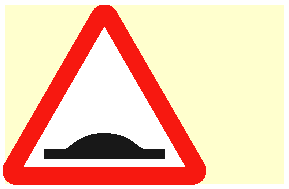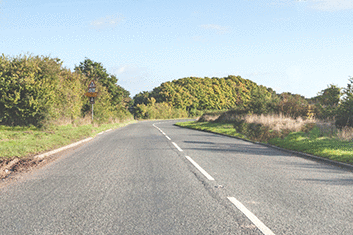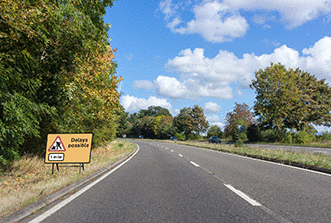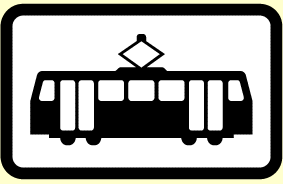Mock Test 5
00:00
Which diagram shows a hazard warning line?
00:00
A police car is following you. What should you do if the police officer flashes the headlights and points to the left?
00:00
You're driving in busy traffic. You want to pull up just after a junction on the left. When should you signal?
00:00
Which vehicle is most likely to take an unusual course at a roundabout?
00:00
What should you do if an instrument panel warning light comes on while you're driving?
00:00
Which plate may appear with this road sign?

00:00
You're waiting to turn right at the end of a road. What should you do if your view is obstructed by parked vehicles?
00:00
You're driving on a road that has a cycle lane. What does it mean if the lane is marked by a broken white line?

00:00
Which sign means there will be two-way traffic crossing your route ahead?
00:00
You arrive at an incident. There's no danger from fire or further collisions and the emergency services have been called. What's your first priority when attending to an unconscious motorcyclist?
00:00
You're leaving your vehicle parked on a road and unattended. When may you leave the engine running?
00:00
What will be affected if the road surface becomes soft in very hot weather?
00:00
When should tyre pressures be checked?
00:00
How much can stopping distances increase in icy conditions?
00:00
Which type of glasses would make driving at night more difficult?
00:00
When may you stop on an urban clearway?
00:00
What's a Statutory Off-Road Notification (SORN)?
00:00
How will a roof rack affect your car?
00:00
What should you do when you're approaching traffic lights that have been green for some time?
00:00
How can you avoid wheelspin when you're driving on an icy road?
00:00
Why should you check for motorcyclists just before turning right into a side road?
00:00
What do you need before you can legally use a motor vehicle on the road?
00:00
You're waiting to come out of a side road. Why should you look carefully for motorcycles?
00:00
You're turning right from a main road into a side road. There's no oncoming traffic. What should you do if pedestrians are standing on the pavement waiting to cross the side road?
00:00
You're approaching a busy junction. What should you do when, at the last moment, you realise you're in the wrong lane?
00:00
What's most likely to increase fuel consumption?
00:00
At an incident, a casualty is unconscious but breathing. When should you move them?
00:00
What should you do to avoid fuel spillage?
00:00
You're travelling on a road that has road humps. What should you do when the driver in front is travelling more slowly than you?

00:00
Which sign shows that you're entering a one-way system?
00:00
What do the long white lines along the centre of the road mean?

00:00
You're travelling in the left-hand lane of a three-lane motorway. How should you react to traffic joining from a slip road?
00:00
You're about to go down a steep hill. What should you do to control the speed of your vehicle?
00:00
Which vehicle might have to take a different course from normal at a roundabout?
00:00
What should you do if the left-hand pavement is closed due to street repairs?
00:00
An injured person has been placed in the recovery position. They're unconscious but breathing normally. What else should be done?
00:00
Your vehicle is stationary. When may you use its horn?
00:00
What should you do when you're following a learner driver who stalls at a junction?
00:00
Which vehicle might have to take a different course from normal at a roundabout?
00:00
Where would you find these flashing red light signals?

00:00
You're driving on this dual carriageway. Why may you need to slow down?

00:00
You want to turn right from a main road into a side road. What should you do just before turning?
00:00
What makes the vehicle in the picture 'environmentally friendly'?

Not enough to pass :-(
You have answered 0 correct out of 43 question(s).
Question: {counter}
{question}
- {options}
